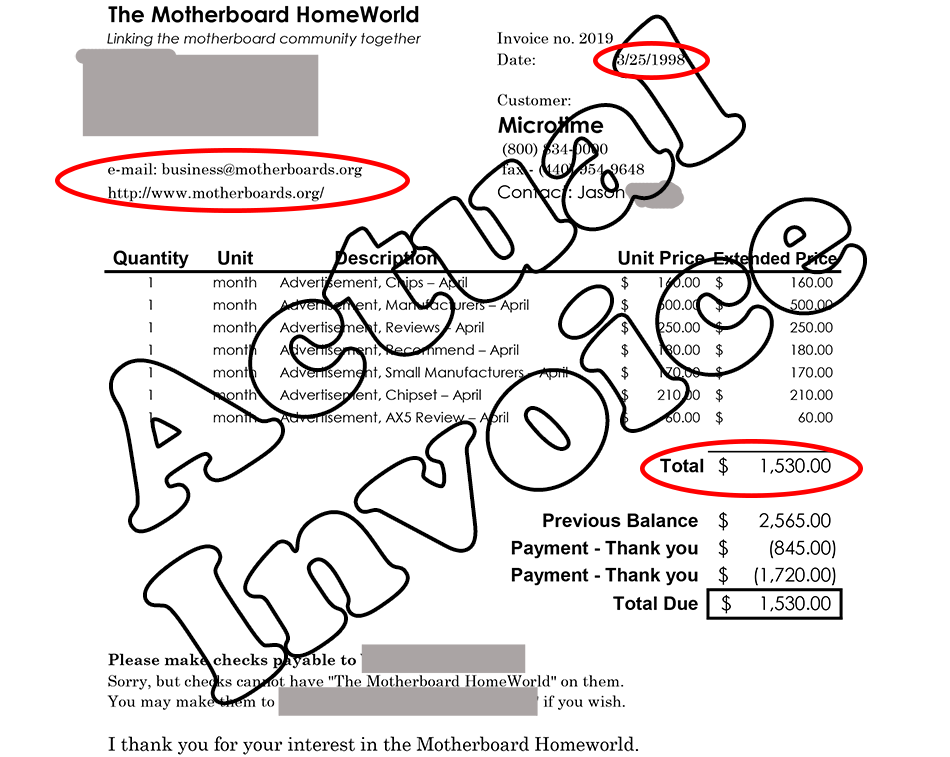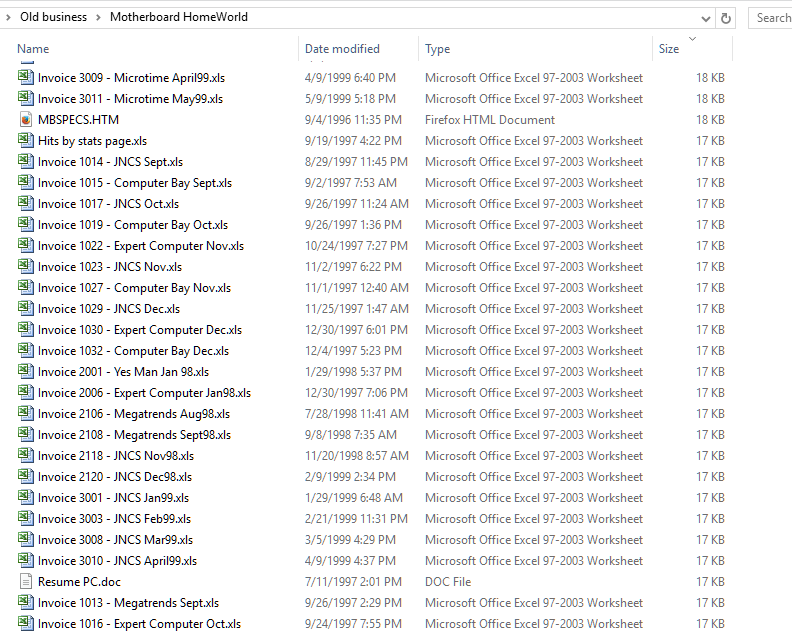Part 4 of the @uruiamme Introduction:
Web Advertising before the dot-com bust
How to advertise a website in the Olden Days!When I first encountered the WWW, the banner ad had long since become a staple of many websites. Certain types of websites used ads to either help out others (Link Exchanges and web rings) or to make a profit off of the service provided.

This is a screenshot of an actual invoice I mailed to a single advertiser for the month of April 1998. This was the old way of selling banner ads before Google conquered the market with AdSense.
Internet search engines needed a lot of resources, so it made sense that they would sell ads that appeared at the top, bottom, or side of the page. The bulk of these ads were graphics, usually GIFs, and were fairly simple. Early web surfers who wanted to block ads simply turned off images in their browser. Later, many resorted to blacklisting known ad servers, a technique that works to some extent even today. And you may recall that Google! got its start in advertising using text-based advertisements.
The prototypical banner ad of the 1990s was the 468x60 pixel rectangle that appeared at the center top or bottom of many web pages. These banner ads were normally a GIF, animated or not, and somewhat gaudy in appearance. JPG banner ads were in the minority, as most text looks bad in JPG files.

(An actual banner ad from 1997. It's a 9 KB animated GIF at 480 by 80 pixels.)
It usually didn’t take a content creator very long to setup one or more of these banner ads to display on his site. The vast majority of sites did not make any significant money with banner ads, link exchanges, and other types of ads. If your site’s content didn’t have any relevancy to the type of ad you placed, your click-through performance would likely be poor.
When I went searching for a banner ad company that would enable my site to make money, I found that my "niche" was never listed. A site geared towards automobiles, investing, computer software, or music would have been easier for me. Sites that fit into those broad categories were welcomed into banner advertising networks. Setting up banner ads on mass-interest websites was easy.
But since my site’s content was not geared towards a major consumer good, it was hard to find an advertisement grouping that made a lot of sense.
Even in that era, advertisers and banner companies understood that relevancy was key to getting clicks and customers and translating that to money.
So when I understood that virtually no one was advertising PC hardware on the web, I decided to build my own advertising service in-house. This was relatively common back in the 1990s, but it was still not particularly easy.
To correctly offer advertisers a series of prices, proof, and purchases, I had to have a banner ad applet installed on my web server. This was one of the few pieces of software that I bought for the website. I acquired a license to host the banner ad rotation applet on my own server. I remember paying in the neighborhood of $80 or so.
Here’s how it worked. After the installation, I could hide a snippet of code in my HTML. The web server, running Apache, would parse this and run the compiled C script on my server, generate some unique HTML code, and then show the banner ad to my web visitor.
This produced a unique trackable link to the advertiser’s landing page. Every time the banner was generated (and presumably shown to a web visitor), a view counter would be incremented on the server. A successful click-through would be tracked by the server, too. With this system setup and tested, I activated it on June 1, 1997. (As a point of comparison, my first banner ad from Corsair Microsystems, shown in Part 3, was put on my website starting in November 1996.)
I had a website capable of thousands of ad impressions per month, high click-through rates, and advertisers calling me to explain how it all worked.
So how did it work?
- A user would visit a page on my site.
- The banner ad applet generated a specific, unique, trackable image and link for that page view
- The visitor would see this image, usually at the top of the page.
- The visitor might click on the image.
- The banner ad applet would then intercept this click and redirect the user to the advertiser's landing page
- The visitor will have left my site, but may quickly return after browsing the other site
- Both my website statistics and the advertiser's would track the click-through rate and conversions
- The advertiser and me should both end up making money
Actual January 1998 Price List for the Motherboard HomeWorld
Home Page* Sold in January to: Megatrends
http://www.motherboards.org/
110,000 (Estimated number of impressions)
$12.00 per CPM*
$1320 for the month
Manufacturers Small Ad Package (four pages)
* Sold in January to: Expert Computer
http://www.motherboards.org/manufacturers/list3.html
http://www.motherboards.org/manufacturers/list6.html
http://www.motherboards.org/manufacturers/list9.html
http://www.motherboards.org/manufacturers/list8.html
23,000 (Estimated number of impressions)
$10.00 per CPM*
$230 for the month
As you can see for those two ad packages, I received $1550 for showing banner ads on my site about 133,000 times. I had quit my “day job” by August 1997. Therefore, advertising on my website was essentially my only income for the latter half of 1997 up until I sold the website to an investor in 1999.
*CPM is an abbreviation used in the advertising industry for "Cost per 1000." For a banner ad, this translated to cost per 1000 impressions. Grammatically, I wrongly added the extra "per" since it is already in the CPM term.
I was unable to sell all of my ads to relevant advertisers. This meant that I had surplus banner ad impressions that could do one of two things:
1. Say “Advertise here” in place of an ad, or
2. Show an irrelevant advertisement.
Believe it or not, the irrelevant ads worked pretty well. I found a pretty lucrative deal in which people would be directed to a really awful, high-interest, high-cost credit card. The fees to apply and get approved were extremely high. But yet, people still clicked through on these ads and signed up. I would get about $20 per sign-up on some cards. I’d get a check in the mail every month or so in the $50 to $150 range. So even the off-topic ads paid me something.

Here's a baddy -- the credit card ad!
The banner ad system was pretty robust. It would rarely fail. And it had all the bells and whistles (I eventually bought the best system available) so I could rotate different ads randomly, cap an ad’s impressions, and show different ads from the same advertiser.
May 1997 saw my first vendor or motherboards and PC clones (and barebones). J&N Computers. Believe it or not, this vendor is still building computers. Today, their website says Contents Copyright 1995-2017. Good old Jerry! I’d still recommend him. He paid all of his bills, which is more than I could say for some of my advertisers!
Manual banner ad rotation, such as the system I used by CentralAd, was technically pretty good. But taking care of all of the advertisers, and their ads, and their accounting departments, and all of the business and taxes involved, was quite a headache. I had one company purposely run up a big bill on advertisements and then go bankrupt. I had some slow payers. And I was expending resources chasing business instead of writing content.
Proof of Invoices
I randomly sorted my old business folder by size, and here's a screen full of invoices for banner ads.
Would you click on these banner ads?
I have offered you a selection of ads to check out. Please comment on 20-year old ads! Would you pay $1000+ per month for banner ads like these to advertise your products? These people did!









Now it's your turn
Follow me, follow me!! @uruiamme is my name. Please like this post and read the next Part. After my introduction, I will be moving on to other juicy topics!!Part 1: My Introduction and the value of content on the web
Part 2: The development and success of the Motherboard HomeWorld, 1996 to 1999
Part 3: Search Engines before the dot-com bust
Part 4: [You are here] Web Advertising before the dot-com bust
Part 5: Blogging before the term existed
Also Check out Private 📬 Messaging using STEEM dollars💲 and public key 🔐 cryptography and
HTML Code Hacks for Steemit.com - What tags work in the Submit a Story Editor
